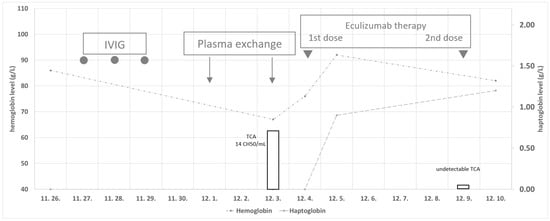Journal Description
Hematology Reports
Hematology Reports
- formerly Hematology Reviews - is an international, peer-reviewed, open access journal on all aspects of prevention, diagnosis and management of disorders of the blood, published quarterly online by MDPI (from Volume 14, Issue 1 - 2022). The Society of Hematologic Oncology Italy (SOHO Italy) is affiliated with Hematology Reports and their members receive discounts on the article processing charges.
- Open Access— free for readers, with article processing charges (APC) paid by authors or their institutions.
- High Visibility: indexed within Scopus, ESCI (Web of Science), PMC, PubMed, Embase, and other databases.
- Rapid Publication: manuscripts are peer-reviewed and a first decision is provided to authors approximately 38.9 days after submission; acceptance to publication is undertaken in 6.8 days (median values for papers published in this journal in the second half of 2023).
- Recognition of Reviewers: APC discount vouchers, optional signed peer review, and reviewer names published annually in the journal.
Impact Factor:
0.9 (2022);
5-Year Impact Factor:
1.0 (2022)
Latest Articles
Eculizumab Treatment of Massive Hemolysis Occurring in a Rare Co-Existence of Paroxysmal Nocturnal Hemoglobinuria and Myasthenia Gravis
Hematol. Rep. 2024, 16(2), 255-259; https://doi.org/10.3390/hematolrep16020025 - 19 Apr 2024
Abstract
►
Show Figures
The co-occurrence of myasthenia gravis (MG) and paroxysmal nocturnal hemoglobinuria (PNH) is rare; only one case has been published so far. We report a 63-year-old Caucasian female patient who was diagnosed with MG at the age of 43. Thymoma was also detected, and
[...] Read more.
The co-occurrence of myasthenia gravis (MG) and paroxysmal nocturnal hemoglobinuria (PNH) is rare; only one case has been published so far. We report a 63-year-old Caucasian female patient who was diagnosed with MG at the age of 43. Thymoma was also detected, and so it was surgically resected, which resulted in reasonable disease control for nearly 20 years. Slight hemolysis began to emerge, and then myasthenia symptoms progressed, so immunosuppressive therapy was started. Due to progressive disease and respiratory failure, the patient underwent plasmapheresis, and ventilatory support was stopped. Marked hemolysis was present, and diagnostic tests confirmed PNH with type III PNH cells. Her myasthenia symptoms aggravated, mechanical ventilation had to be started again, and due to the respiratory acidosis, massive hemolysis occurred. After two plasmapheresis sessions, the patient received eculizumab at 600 mg, resulting in prompt hemolysis control. After the second dose of the treatment, the patient was extubated. Still, due to their inability to cough, she developed another respiratory failure and pneumonia–sepsis, resulting in the patient’s death. This case highlights the rare association between these two serious diseases and similar immune-mediated pathophysiology mechanisms involving the complement system.
Full article
Open AccessReview
A 2024 Update on Menin Inhibitors. A New Class of Target Agents against KMT2A-Rearranged and NPM1-Mutated Acute Myeloid Leukemia
by
Anna Candoni and Gabriele Coppola
Hematol. Rep. 2024, 16(2), 244-254; https://doi.org/10.3390/hematolrep16020024 - 18 Apr 2024
Abstract
►▼
Show Figures
Menin inhibitors are new and promising agents currently in clinical development that target the HOX/MEIS1 transcriptional program which is critical for leukemogenesis in histone-lysine N-methyltransferase 2A-rearranged (KMT2Ar) and in NPM1-mutated (NPM1mut) acute leukemias. The mechanism of action of this new class of agents
[...] Read more.
Menin inhibitors are new and promising agents currently in clinical development that target the HOX/MEIS1 transcriptional program which is critical for leukemogenesis in histone-lysine N-methyltransferase 2A-rearranged (KMT2Ar) and in NPM1-mutated (NPM1mut) acute leukemias. The mechanism of action of this new class of agents is based on the disruption of the menin–KMT2A complex (consisting of chromatin remodeling proteins), leading to the differentiation and apoptosis of AML cells expressing KMT2A or with mutated NPM1. To date, this new class of drugs has been tested in phase I and II clinical trials, both alone and in combination with synergistic drugs showing promising results in terms of response rates and safety in heavily pre-treated acute leukemia patients. In this brief review, we summarize the key findings on menin inhibitors, focusing on the mechanism of action and preliminary clinical data on the treatment of acute myeloid leukemia with this promising new class of agents, particularly revumenib and ziftomenib.
Full article

Figure 1
Open AccessCommunication
Post-Transplant Cyclophosphamide versus Anti-Thymocyte Globulin in Patients with Hematological Malignancies Treated with Allogeneic Hematopoietic Stem Cell Transplantation from Haploidentical and Matched Unrelated Donors: A Real-Life Experience
by
Bianca Serio, Gabriella Storti, Matteo D’Addona, Lidia Santoro, Camilla Frieri, Danilo De Novellis, Luana Marano, Giovanna De Santis, Roberto Guariglia, Ilenia Manfra, Eleonora Urciuoli, Serena Luponio, Serena Marotta, Denise Morini, Michela Rizzo, Fausto Palmieri, Nicola Cantore, Valentina Giudice, Antonio Maria Risitano and Carmine Selleri
Hematol. Rep. 2024, 16(2), 234-243; https://doi.org/10.3390/hematolrep16020023 - 17 Apr 2024
Abstract
►▼
Show Figures
Background: Post-transplant cyclophosphamide (PTCY) is widely used as graft versus host disease (GvHD) prophylaxis in allogeneic hematopoietic stem cell transplant (HSCT) recipients, with reported clinical benefits in patients who underwent transplant from a matched unrelated donor (MUD). However, real-life data on clinical efficacy
[...] Read more.
Background: Post-transplant cyclophosphamide (PTCY) is widely used as graft versus host disease (GvHD) prophylaxis in allogeneic hematopoietic stem cell transplant (HSCT) recipients, with reported clinical benefits in patients who underwent transplant from a matched unrelated donor (MUD). However, real-life data on clinical efficacy and safety of PTCY in haploidentical and MUD transplantations are still poor. Methods: In our real-life retrospective observational study, we included a total of 40 consecutive adult patients who underwent haploidentical or MUD HSCT for various hematological malignancies and who received PTCY (n = 24) or ATG (n = 16) as GvHD prophylaxis at Hematology Units from hospitals of Salerno and Avellino, Italy, and clinical outcomes were compared. Results: We showed protective effects of PTCY against disease relapse with the relapse rate after transplantation of 16% versus 50% in the ATG arm (p = 0.02). All-cause mortality was lower (36% vs. 75%; p = 0.02) and the 2-year overall survival was slightly superior in patients administered PTCY (61% vs. 42%; p = 0.26). Conclusions: We support the use of PTCY, even in a real-life setting; however, the optimization of this protocol should be further investigated to better balance relapse prevention and GvHD prophylaxis.
Full article
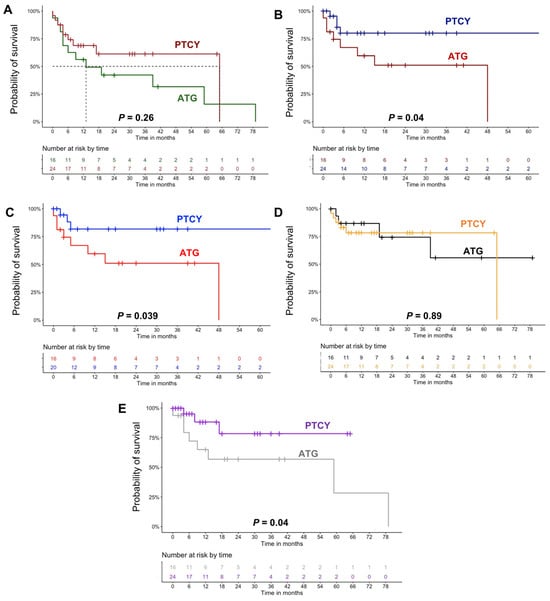
Figure 1
Open AccessArticle
Monitoring Humoral Response Following BNT162b2 mRNA Vaccination against SARS-CoV-2 in Hematopoietic Stem-Cell Transplantation Patients: A Single-Center Prospective Study along with a Brief Review of Current Literature
by
John V. Asimakopoulos, Eleni Lalou, George Seferlis, Maria Malliarou, Eliana Konstantinou, Ioannis Drandakis, Ioannis Vasilopoulos, Angeliki N. Georgopoulou, Anastasia Kopsaftopoulou, Alexandros Machairas, Alexia Piperidou, Anestis Karapaschalidis, Maria-Ekaterini Lefaki, Dimitrios Galopoulos, Maria-Panagiota Arapaki, Panagiota Petsa, Ekaterini Benekou, Marina P. Siakantaris, Athanasios G. Papavassiliou, Panagiotis Tsaftaridis, Panayiotis Panayiotidis, Theodoros P. Vassilakopoulos, Angeliki Papapanagiotou and Maria K. Angelopoulouadd
Show full author list
remove
Hide full author list
Hematol. Rep. 2024, 16(2), 220-233; https://doi.org/10.3390/hematolrep16020022 - 16 Apr 2024
Abstract
►▼
Show Figures
Data on antibody response (AR) after vaccination against SARS-CoV2 in hematopoietic stem-cell transplantation setting (HSCT) were initially scarce, mainly due to the exclusion of such patients from approval studies. Shortly after the worldwide application of vaccination against SARS-CoV-2 in vulnerable populations such as
[...] Read more.
Data on antibody response (AR) after vaccination against SARS-CoV2 in hematopoietic stem-cell transplantation setting (HSCT) were initially scarce, mainly due to the exclusion of such patients from approval studies. Shortly after the worldwide application of vaccination against SARS-CoV-2 in vulnerable populations such as patients with hematologic malignancies, limited single-center trials, including HSCT patients, were published. However, there was a great heterogeneity between them regarding the type of underlying malignancy, co-current treatment, type of vaccine, method of AR measurement, and time point of AR measurement. Herein, we present the results of a prospective study on AR after vaccination for SARS-CoV-2 using the BNT162b2 vaccine in a cohort of 54 HSCT recipients—mostly autologous from a single Unit—along with a broad review of the current literature. In our cohort, the AR positivity rate at 1 month was 80.8% and remained positive in 85.7% of patients at 3 months after vaccination. There were only nine non-responders, who were more heavily pretreated and more frequently hypogammaglobulinemic compared to responders. High antibody titers (AT), [AT ≥ 1000 U/mL], were detected in 38.5% and 30.6% of the patients at m1 and m3, respectively. A significant decline in AT between m1 and m3 was demonstrated—p < 0.0001; median AT1 and AT3 were 480.5 and 293 U/mL, respectively. A novel finding of our study was the negative impact of IgA hypogammaglobulinemia on response to vaccination. Other negative significant factors were treatment with anti-CD20 antibody at vaccination and vaccination within 18 months from HSCT. Our data indicate that HSCT recipients elicit a positive response to the BNT162b2 vaccine against SARS-CoV-2 when vaccinated at 6 months post-transplant, and vaccination should be offered to this patient population even within the post-pandemic COVID-19 era.
Full article

Figure 1
Open AccessReview
Pathophysiology, Clinical Manifestations and Diagnosis of Immune Thrombocytopenia: Contextualization from a Historical Perspective
by
Daniel Martínez-Carballeira, Ángel Bernardo, Alberto Caro, Inmaculada Soto and Laura Gutiérrez
Hematol. Rep. 2024, 16(2), 204-219; https://doi.org/10.3390/hematolrep16020021 - 03 Apr 2024
Abstract
►▼
Show Figures
Immune thrombocytopenia (ITP) is an autoimmune disease characterized by an isolated decrease in the platelet count and an increased risk of bleeding. The pathogenesis is complex, affecting multiple components of the immune system and causing both peripheral destruction of platelets and impaired central
[...] Read more.
Immune thrombocytopenia (ITP) is an autoimmune disease characterized by an isolated decrease in the platelet count and an increased risk of bleeding. The pathogenesis is complex, affecting multiple components of the immune system and causing both peripheral destruction of platelets and impaired central megakaryopoiesis and platelet production in the bone marrow. Here, we intend to contextualize the current knowledge on the pathophysiology, terminology, epidemiology, clinical manifestations, diagnosis, and prognosis of ITP from a historical perspective and the first references to the never-stopping garnering of knowledge about this entity. We highlight the necessity to better understand ITP in order to be able to provide ITP patients with personalized treatment options, improving disease prognosis and reducing the incidence or frequency of refractoriness.
Full article
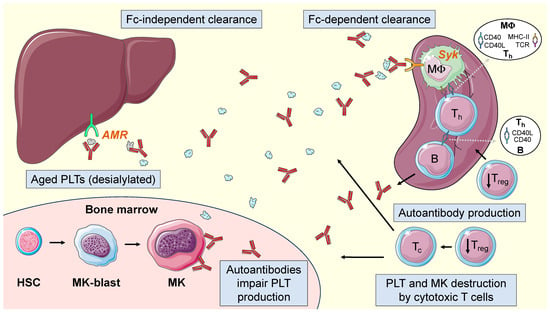
Figure 1
Open AccessReview
Ophthalmic Manifestations in Patients with Blood Malignancies
by
Costanza Rossi, Alessandro Buizza, Giuseppe Alessio, Massimiliano Borselli, Andrea Taloni, Adriano Carnevali, Giovanna Carnovale Scalzo, Andrea Lucisano, Vincenzo Scorcia and Giuseppe Giannaccare
Hematol. Rep. 2024, 16(2), 193-203; https://doi.org/10.3390/hematolrep16020020 - 28 Mar 2024
Abstract
►▼
Show Figures
Ocular complications can occur in up to 90% of patients with blood malignancies. Such complications range from direct infiltration to local hemostatic imbalance and treatment-related toxicity. This narrative review is based on a systematic computerized search of the literature conducted until January 2024
[...] Read more.
Ocular complications can occur in up to 90% of patients with blood malignancies. Such complications range from direct infiltration to local hemostatic imbalance and treatment-related toxicity. This narrative review is based on a systematic computerized search of the literature conducted until January 2024 and examines the common ocular complications associated with blood cancers. Ocular complications from primary disease include mass effects from ocular adnexal lymphomas and intraocular lymphomas, with B-cell lymphomas accounting for 95% of primary ocular presentations. Secondary disease involvement from systemic hematological malignancies can lead to a wide range of ocular manifestations, such as leukemic retinopathy. Furthermore, toxicity from antineoplastic therapies and ocular graft versus host disease (oGVHD) after hematopoietic stem cell transplantation present additional risks to ocular health. In conclusion, ocular complications in blood cancer patients are an integral part of patient management, requiring regular ophthalmic evaluations and close collaboration between oncologists and ophthalmologists. Advances in therapy and an increased focus on early symptom recognition are essential for preserving vision and enhancing patient quality of life.
Full article
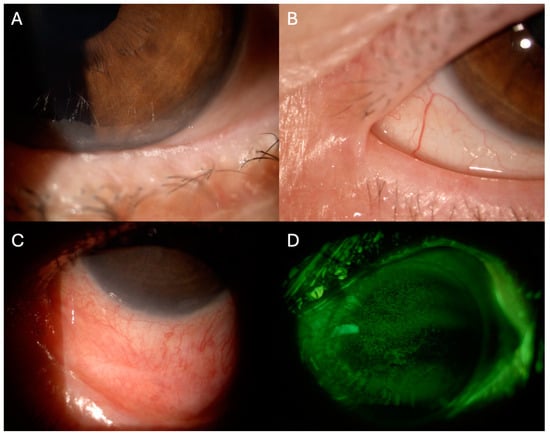
Figure 1
Open AccessCase Report
Partial Splenic Embolization in a Patient with Hemophilia A and Severe Thrombocytopenia: A Case Report
by
Tomofumi Nakamura, Mitsuhiro Uchiba, Hirotomo Nakata, Takao Mizumoto, Toru Beppu and Shuzo Matsushita
Hematol. Rep. 2024, 16(2), 185-192; https://doi.org/10.3390/hematolrep16020019 - 26 Mar 2024
Abstract
►▼
Show Figures
We report a patient with hemophilia A who underwent partial splenic embolization (PSE) for severe thrombocytopenia secondary to portal hypertension-induced splenomegaly, resulting in a stable long-term quality of life. The patient was diagnosed with hemophilia A and unfortunately contracted human immunodeficiency virus (HIV),
[...] Read more.
We report a patient with hemophilia A who underwent partial splenic embolization (PSE) for severe thrombocytopenia secondary to portal hypertension-induced splenomegaly, resulting in a stable long-term quality of life. The patient was diagnosed with hemophilia A and unfortunately contracted human immunodeficiency virus (HIV), hepatitis B virus (HBV), and hepatitis C virus (HCV) from blood products. He subsequently developed progressive splenomegaly due to portal hypertension from chronic HCV, resulting in severe thrombocytopenia. PSE was performed because he had occasional subcutaneous bleeding and needed to start interferon (IFN) and ribavirin (RBV) treatment for curing his HCV infection at that time. His platelet counts increased, and no serious adverse events were observed. Currently, he continues to receive outpatient treatment, regular factor VIII (FVIII) replacement therapy for hemophilia A, and antiretroviral therapy for HIV infection. Vascular embolization has been reported to be an effective and minimally invasive treatment for bleeding in hemophilia patients. PSE also provided him with a stable quality of life without the side effects of serious infections and thrombocytopenia relapses. We conclude that PSE is a promising therapeutic option for patients with hemophilia A.
Full article

Figure 1
Open AccessCase Report
Indolent T Cell Lymphoproliferation of the Gastrointestinal Tract: An Evolving Disease Entity
by
Luke Wang, Elaine Koh, Beena Kumar and Michael S. Y. Low
Hematol. Rep. 2024, 16(2), 179-184; https://doi.org/10.3390/hematolrep16020018 - 22 Mar 2024
Abstract
►▼
Show Figures
Background: Indolent T cell lymphoproliferation of the gastrointestinal tract is a novel entity recently added to the 2016 WHO classification of lymphoid neoplasms. Classically, these patients demonstrate an immunophenotype consistent with T cell proliferation and can be either CD4-positive or CD8-positive but with
[...] Read more.
Background: Indolent T cell lymphoproliferation of the gastrointestinal tract is a novel entity recently added to the 2016 WHO classification of lymphoid neoplasms. Classically, these patients demonstrate an immunophenotype consistent with T cell proliferation and can be either CD4-positive or CD8-positive but with a low Ki67 index, highlighting the indolent nature of this disease compared to its more aggressive T cell lymphoma counterparts such as enteropathy-associated T cell lymphoma and monomorphic epitheliotropic intestinal T cell lymphoma. Methods: Here, we describe one rare case of such a neoplasm under our care, initially presenting with non-specific signs and symptoms and requiring extensive investigations to diagnose. Available cases in the literature reflect a wide variety of ages and ethnicities affected, and any part of the gastrointestinal sites can be affected, which makes diagnosis difficult and prolonged; however, progression beyond lymph nodes is rare, and prognosis is otherwise favourable, particularly if CD8-positive. The optimal management of these patients remains yet to be defined, given the paucity of available cases currently. The current evidence suggests the utility of steroids, cyclosporine, radiotherapy, and a potential role for JAK inhibitors. Conclusions: Our case showed an excellent response to the initial course of steroids, with a subsequent successful transition to cyclosporine, keeping symptoms at bay with ongoing stable disease.
Full article
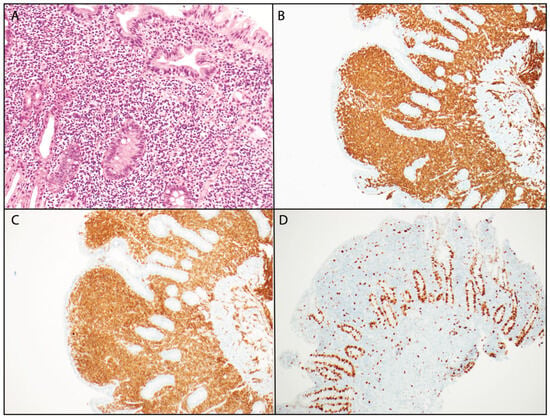
Figure 1
Open AccessReview
Navigating Lymphomas through BCR Signaling and Double-Hit Insights: Overview
by
Antonella Argentiero, Alessandro Andriano, Donatello Marziliano and Vanessa Desantis
Hematol. Rep. 2024, 16(1), 164-178; https://doi.org/10.3390/hematolrep16010017 - 21 Mar 2024
Abstract
►▼
Show Figures
Non-Hodgkin’s lymphomas (NHLs) are a heterogeneous group of lymphoproliferative disorders originating from B, T, or NK lymphocytes. They represent approximately 4–5% of new cancer cases and are classified according to the revised WHO system based on cell lineage, morphology, immunophenotype, and genetics. Diagnosis
[...] Read more.
Non-Hodgkin’s lymphomas (NHLs) are a heterogeneous group of lymphoproliferative disorders originating from B, T, or NK lymphocytes. They represent approximately 4–5% of new cancer cases and are classified according to the revised WHO system based on cell lineage, morphology, immunophenotype, and genetics. Diagnosis requires adequate biopsy material, though integrated approaches are used for leukemic presentations. Molecular profiling is improving classification and identifying prognostic markers. Indolent NHLs, such as follicular lymphoma and marginal zone lymphoma, typically pursue a non-aggressive clinical course with long survival. Aggressive diffuse large B-cell lymphoma (DLBCL) is the most common subtype. Recent studies have elucidated pathogenic mechanisms like MYC translocations and BCR pathway mutations. “Double hit” lymphomas with MYC and BCL2/BCL6 alterations confer a poor prognosis. Treatment approaches are evolving, with chemoimmunotherapy remaining standard for many indolent cases while intensified regimens and targeted agents show promise for refractory or high-risk aggressive disease. Continued elucidation of the genetic and microenvironmental underpinnings of lymphomagenesis is critical for developing personalized therapeutic strategies.
Full article
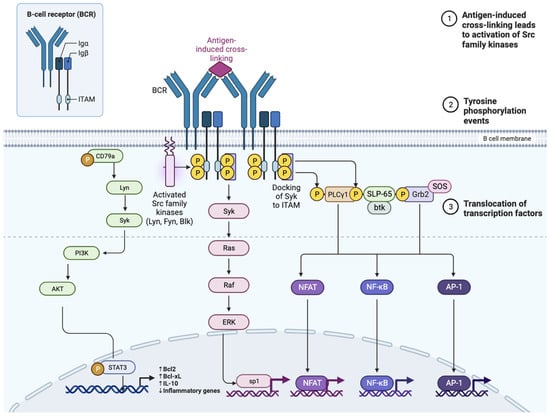
Figure 1
Open AccessReview
Drug–Drug Interactions of FXI Inhibitors: Clinical Relevance
by
Nicola Ferri, Elisa Colombo and Alberto Corsini
Hematol. Rep. 2024, 16(1), 151-163; https://doi.org/10.3390/hematolrep16010016 - 21 Mar 2024
Abstract
►▼
Show Figures
Inhibitors of the factor FXI represent a new class of anticoagulant agents that are facing clinical approval for the treatment of acute coronary syndrome (ACS), venous thromboembolism (VTE), and stroke prevention of atrial fibrillation (AF). These new inhibitors include chemical small molecules (asundexian
[...] Read more.
Inhibitors of the factor FXI represent a new class of anticoagulant agents that are facing clinical approval for the treatment of acute coronary syndrome (ACS), venous thromboembolism (VTE), and stroke prevention of atrial fibrillation (AF). These new inhibitors include chemical small molecules (asundexian and milvexian), monoclonal antibodies (abelacimab, osocimab, and xisomab), and antisense oligonucleotides (IONIS-FXIRX and fesomersen), and thus, they have very peculiar and different pharmacokinetic and pharmacodynamic properties. Besides their clinical efficacy and safety, based on their pharmacological heterogeneity, the use of these drugs in patients with comorbidities may undergo drug–drug interactions (DDIs) with other concomitant therapies. Although only little clinical evidence is available, it is possible to predict clinically relevant DDI by taking into consideration their pharmacokinetic properties, such as the CYP450-dependent metabolism, the interaction with drug transporters, and/or the route of elimination. These characteristics may be useful to differentiate their use with the direct oral anticoagulant (DOAC) anti -FXa (rivaroxaban, apixaban, edoxaban) and thrombin (dabigatran), whose pharmacokinetics are strongly dependent from P-gp inhibitors/inducers. In the present review, we summarize the current clinical evidence on DDIs of new anti FXI with CYP450/P-gp inhibitors and inducers and indicate potential differences with DOAC anti FXa.
Full article
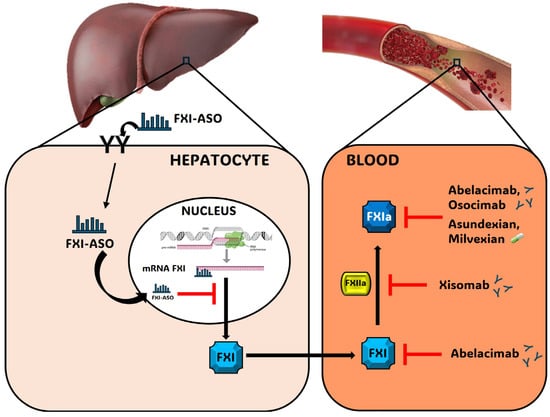
Figure 1
Open AccessArticle
The Cardiovascular Event Risk Associated with Tyrosine Kinase Inhibitors and the Lipid Profile in Patients with Chronic Myeloid Leukemia
by
María Nieves Saez Perdomo, Ruth Stuckey, Elena González-Pérez, Santiago Sánchez-Sosa, Paula Estupiñan-Cabrera, Sunil Lakhwani Lakhwani, José David González San Miguel, Nuria Hernanz Soler, Marina Gordillo, Gloria González Brito, María Tapia-Torres, Ana Ruano, Adrián Segura-Díaz, Hugo Luzardo, Cristina Bilbao-Sieyro and María Teresa Gómez-Casares
Hematol. Rep. 2024, 16(1), 140-150; https://doi.org/10.3390/hematolrep16010015 - 12 Mar 2024
Abstract
►▼
Show Figures
Background: Second- and third-generation tyrosine kinase inhibitors (TKIs) are now available to treat chronic-phase chronic myeloid leukemia (CP-CML) in the first and second line. However, vascular adverse events (VAEs) have been reported for patients with CML treated with some TKIs. Methods: We retrospectively
[...] Read more.
Background: Second- and third-generation tyrosine kinase inhibitors (TKIs) are now available to treat chronic-phase chronic myeloid leukemia (CP-CML) in the first and second line. However, vascular adverse events (VAEs) have been reported for patients with CML treated with some TKIs. Methods: We retrospectively evaluated the cumulative incidence (CI) and cardiovascular risk for 210 patients included in the Canarian Registry of CML. Result: With a mean follow up of 6 years, 19/210 (9.1%) patients developed VAEs, all of whom presented at least one cardiovascular risk factor at diagnosis. The mean time to VAE presentation was 54 months from the start of TKI treatment. We found a statistically significant difference between the CI for nilotinib-naïve vs. nilotinib-treated patients (p = 0.005), between dasatinib-naïve and dasatinib-treated patients (p = 0.039), and for patients who received three lines of treatment with first-line imatinib vs. first-line imatinib (p < 0.001). From the multivariable logistic regression analyses, the Framingham risk score (FRS) and patients with three lines of TKI with first-line imatinib were the only variables with statistically significant hazard ratios for VAE development. Significant increases in HDL-C and total cholesterol may also be predictive for VAE. Conclusions: In conclusion, it is important to estimate the cardiovascular risk at the diagnosis of CML as it can help determine whether a patient is likely to develop a VAE during TKI treatment.
Full article
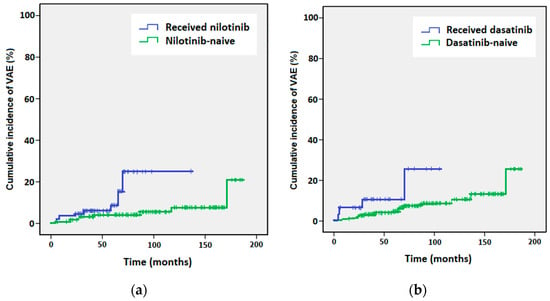
Figure 1
Open AccessCase Report
Factor VII Deficiency in Systemic Mastocytosis with an Associated Myeloid Neoplasm
by
Giorgio Rosati, Sofia Camerlo, Alessandro Fornari, Valerio Marci, Barbara Montaruli and Alessandro Morotti
Hematol. Rep. 2024, 16(1), 132-139; https://doi.org/10.3390/hematolrep16010014 - 12 Mar 2024
Abstract
Factor VII (FVII) deficiency is a rare bleeding disorder that can be classified as congenital or acquired, and the majority of acquired cases are due to vitamin K deficiency or liver disease. Isolated acquired FVII deficiency is a rare occurrence and has been
[...] Read more.
Factor VII (FVII) deficiency is a rare bleeding disorder that can be classified as congenital or acquired, and the majority of acquired cases are due to vitamin K deficiency or liver disease. Isolated acquired FVII deficiency is a rare occurrence and has been associated with inhibitors or auto-antibodies. Here, we describe a patient with polycythemia vera who developed systemic mastocytosis and FVII deficiency simultaneously. FVII deficiency was not caused by inhibitors and improved with antineoplastic treatment. Acquired FVII deficiency has been reported in cases of sepsis, possibly due to proteolytic degradation induced by the activation of monocytes or endothelial cells. Malignancies have been shown to cause a depletion in circulating FVII through the direct binding of cancer cells. This case report suggests a potential association between SM associated with a hematological neoplasm (SM-AHN) and acquired FVII deficiency. Further evaluations are recommended in patients with systemic mastocytosis to gain a better understanding of the relationship between pathological mast cells and clotting factor concentrations.
Full article
(This article belongs to the Special Issue Personalized Therapy and Clinical Outcomes for Congenital and Acquired Haemorrhagic Disorders, Thromboembolic Disease and Platelet Disorders)
►▼
Show Figures
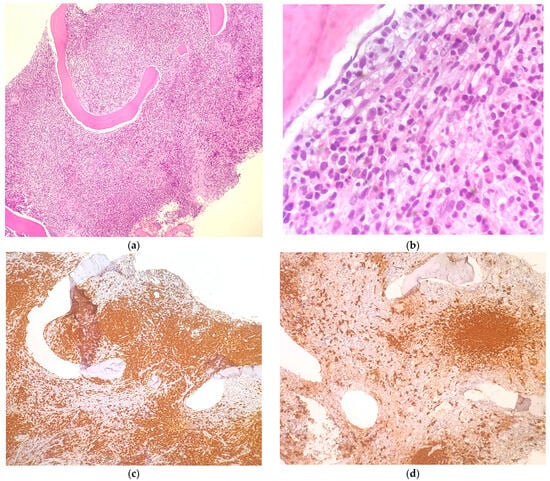
Figure 1
Open AccessCase Report
Uncommon Presentation of Sarcoidosis with Severe Thrombocytopenia and Hemorrhagic Diathesis
by
Dorela Lame, Michelangelo Pianelli, Shahram Kordasti, Erika Morsia, Attilio Olivieri and Antonella Poloni
Hematol. Rep. 2024, 16(1), 125-131; https://doi.org/10.3390/hematolrep16010013 - 04 Mar 2024
Abstract
►▼
Show Figures
Sarcoidosis, a multi-organ system disease, often presents insidiously. Thrombocytopenia in sarcoidosis is frequent because of hypersplenism, granulomas infiltrating the bone marrow, or immune thrombocytopenia (ITP). The diagnosis of ITP relies on exclusionary criteria, given the absence of a definitive laboratory diagnostic feature. In
[...] Read more.
Sarcoidosis, a multi-organ system disease, often presents insidiously. Thrombocytopenia in sarcoidosis is frequent because of hypersplenism, granulomas infiltrating the bone marrow, or immune thrombocytopenia (ITP). The diagnosis of ITP relies on exclusionary criteria, given the absence of a definitive laboratory diagnostic feature. In the era prior to modern ITP management, sarcoidosis-associated ITP was known to manifest severely, often showing resistance to treatment and an increased risk of mortality. In this case, we present a young male who was admitted to a district hospital’s emergency room, displaying symptoms of hematuria, gingival bleeding, and a petechial rash. Blood tests revealed severe thrombocytopenia with a platelet count of 0, while all other metabolic and serological exams returned normal results. Infectious and autoimmune causes were ruled out, and a bone marrow examination excluded any hematological disorder. Initial management, including platelet transfusion and presumptive treatment for ITP with dexamethasone and Human Immunoglobulin IV (IVIG), failed to improve the patient’s platelet count or alleviate the hemorrhagic diathesis. Second-line therapy with Rituximab and Methylprednisolone was initiated with no benefit. Considering the hemorrhagic signs and the delayed response of Rituximab, we shifted to third-line therapy with Romiplostim at the maximal dose and continued Methylprednisolone. The platelet count recovered completely after the second Romiplostim administration (over 350 × 109 platelets/L) and Methylprednisolone was rapidly tapered. To further study the causes of thrombocytopenia a total body CT scan was performed and it identified non-homogeneously hypodense tissue in the bilateral hilar area extending medially to the subcarinal area, suggesting possible lymphatic origin and raising suspicion of sarcoidosis. Further investigations, including Angiotensin Converting Enzyme (ACE) titration, bronchoscopy, bronchoalveolar lavage, and EndoBronchial UltraSound-guided TransBronchial Needle Aspiration (EBUS-TBNA), confirmed the diagnosis of sarcoidosis. Despite a mild restrictive insufficiency noted in spirometry, the patient remained asymptomatic with only a mild respiratory insufficiency, and hence, was enlisted for follow-up. As for the ITP, the platelet count remained normal over a year. Notably, while sarcoidosis onset often predates ITP onset by an average of 48 months, in our case the onset of the two diseases was simultaneously. Our case adds valuable information to the limited body of knowledge regarding the treatment of sarcoidosis-associated ITP.
Full article
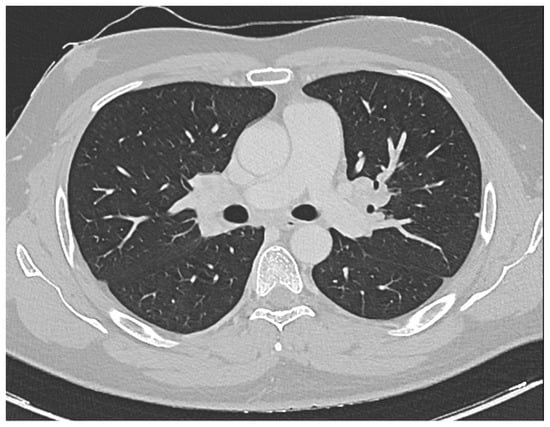
Figure 1
Open AccessArticle
Impact of Skeletal Muscle Depletion on Patients with Myelodysplastic Syndrome Treated with Azacitidine
by
Eri Takada, Nobuhiko Nakamura, Yuto Kaneda, Kenji Fukuno, Shin Lee, Kei Fujita, Tetsuji Morishita, Yoshikazu Ikoma, Takuro Matsumoto, Hiroshi Nakamura, Junichi Kitagawa, Nobuhiro Kanemura, Senji Kasahara, Takeshi Hara, Hisashi Tsurumi and Masahito Shimizu
Hematol. Rep. 2024, 16(1), 114-124; https://doi.org/10.3390/hematolrep16010012 - 28 Feb 2024
Abstract
►▼
Show Figures
Background: Azacitidine (AZA) is the standard treatment for patients with high-risk myelodysplastic syndromes (MDS). The impact of skeletal muscle depletion (SMD), which is associated with outcomes of hematological malignancies, on the clinical course of MDS patients treated with AZA was investigated. Methods: This
[...] Read more.
Background: Azacitidine (AZA) is the standard treatment for patients with high-risk myelodysplastic syndromes (MDS). The impact of skeletal muscle depletion (SMD), which is associated with outcomes of hematological malignancies, on the clinical course of MDS patients treated with AZA was investigated. Methods: This retrospective, observational study included 50 MDS patients treated with AZA. Muscle mass was evaluated using the skeletal muscle index (SMI), which is the area of muscle mass at the third lumbar vertebra on CT images divided by the square of the height. Results: Of the enrolled patients, 39 were males, and their median age was 69.5 years. Twenty-seven (20 male and 7 female) patients showed SMD. The median survival was 13.4 months in the SMD group and 15.2 months in the non-SMD group, with no significant difference and no significant association between the response rate or severe non-hematological toxicities and the presence of SMD. By contrast, grade 3–4 anemia and thrombocytopenia were significantly more frequent in the SMD group than in the non-SMD group. SMD was associated with severe anemia and thrombocytopenia in MDS patients treated with AZA. Conclusion: Reduced skeletal muscle mass may predict severe hematological toxicity in MDS patients treated with AZA.
Full article
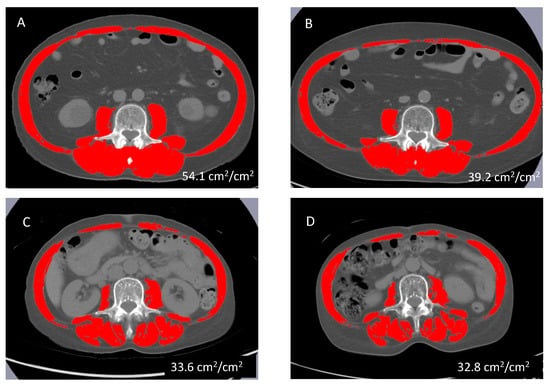
Figure 1
Open AccessCase Report
Primary Bone Lymphoma of the Scapula
by
Josip Lovaković, Inga Mandac Smoljanović, Andro Matković and Tomislav Smoljanović
Hematol. Rep. 2024, 16(1), 106-113; https://doi.org/10.3390/hematolrep16010011 - 28 Feb 2024
Abstract
►▼
Show Figures
Primary bone lymphoma of the scapula is a rare tumor that usually causes local pain. The presented patient suffered for two years from paresthesia, tingling, numbness, and edema of the little and ring fingers. The 45-year-old man underwent several radiological and neurological assessments
[...] Read more.
Primary bone lymphoma of the scapula is a rare tumor that usually causes local pain. The presented patient suffered for two years from paresthesia, tingling, numbness, and edema of the little and ring fingers. The 45-year-old man underwent several radiological and neurological assessments of the palm, elbow, and neck before radiographs revealed a tumor of the left shoulder. Once diffuse large B-cell lymphoma was confirmed, immunochemotherapy with rituximab, cyclophosphamide, doxorubicin, vincristine, and methylprednisolone (R-CHOP) started. The treatment was accompanied by antiviral treatment with lamivudine due to positive hepatitis B virus serology, specifically anti-HBs (hepatitis B surface) antibody, total anti-HBc (hepatitis B core) antibody, and anti-HBe (hepatitis B e antigen) antibody, together with bisphosphonate treatment for the prevention of bone resorption. Once immunochemotherapy was finished, the treatment was supplemented by radiotherapy of the shoulder. After more than three years of remission, the patient had an ischemic stroke manifesting with right-sided hemiparesis. Following physical therapy, the patient is currently in the process of evaluation for thrombophilia, as well as further cardiac assessment due to the positive transcranial Doppler bubble test, setting high suspicion for the presence of patent foramen ovale.
Full article

Figure 1
Open AccessCase Report
Successful Bone Marrow Transplantation in a Patient with Acute Myeloid Leukemia Developed from Severe Congenital Neutropenia Using Modified Chemotherapy and Conditioning Regimen for Leukemia
by
Risa Matsumura, Shinji Mochizuki, Yusuke Morishita, Hiroko Hayakawa, Shuhei Karakawa, Hiroshi Kawaguchi, Satoshi Okada, Nobuyuki Hyakuna and Masao Kobayashi
Hematol. Rep. 2024, 16(1), 98-105; https://doi.org/10.3390/hematolrep16010010 - 26 Feb 2024
Abstract
Severe congenital neutropenia (SCN) is characterized by chronic neutropenia with recurrent infections from early infancy and a predisposition to myelodysplastic syndrome/acute myeloid leukemia (AML). Allogeneic hematopoietic stem cell transplantation (HSCT) is the only curative treatment for patients with SCN who develop myelodysplastic syndrome/AML.
[...] Read more.
Severe congenital neutropenia (SCN) is characterized by chronic neutropenia with recurrent infections from early infancy and a predisposition to myelodysplastic syndrome/acute myeloid leukemia (AML). Allogeneic hematopoietic stem cell transplantation (HSCT) is the only curative treatment for patients with SCN who develop myelodysplastic syndrome/AML. We report an 8-year-old girl with SCN carrying an ELANE mutation that had been refractory to granulocyte colony-stimulating factor. The patient experienced recurrent infections and then developed AML. The counts of leukemic blasts that harbored both CSF3R and RUNX1 mutations spontaneously decreased with antimicrobial therapy, leading to partial remission. After AML recurrence, HSCT was successfully performed using modified chemotherapy and a conditioning regimen. Serial donor lymphocyte infusions against mixed chimerism induced complete donor chimerism over 4 years without any infections or AML relapse. This case suggests the importance of carefully managing neutropenia-related infections, leukemia progression, and HSCT in patients with SCN developing AML.
Full article
(This article belongs to the Special Issue Diagnosis and Management of Acute Leukemia(AML, ALL): Drafting from Molecular Mechanisms to Clinical Practice)
►▼
Show Figures
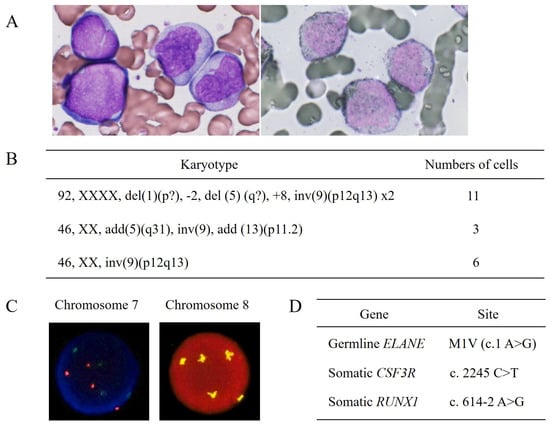
Figure 1
Open AccessArticle
Prevalence, Outcomes and Impact of Disease-Related Complications in the Survival of Multiple Myeloma Patients
by
Wachiralak Tothong, Adisak Tantiworawit, Lalita Norasetthada, Chatree Chai-Adisaksopha, Teerachat Punnachet, Nonthakorn Hantrakun, Pokpong Piriyakhuntorn, Thanawat Rattanathammethee, Sasinee Hantrakool and Ekarat Rattarittamrong
Hematol. Rep. 2024, 16(1), 89-97; https://doi.org/10.3390/hematolrep16010009 - 21 Feb 2024
Abstract
►▼
Show Figures
There are limited data regarding the impact of disease-related complications on the survival of multiple myeloma (MM) patients. The primary objective of this study was to determine the prevalence of disease-related complications, including hypercalcemia, renal insufficiency, anemia, and bone lytic lesions in MM
[...] Read more.
There are limited data regarding the impact of disease-related complications on the survival of multiple myeloma (MM) patients. The primary objective of this study was to determine the prevalence of disease-related complications, including hypercalcemia, renal insufficiency, anemia, and bone lytic lesions in MM patients. The secondary objectives were to determine clinical characteristics, treatment outcomes, and the association of disease-related complications and mortality. A retrospective chart review of MM patients from November 2014 to December 2019 was conducted. A total of 200 MM patients were enrolled. The median age at diagnosis was 63 years. The bone lytic lesion was the most common disease-related complication found in 85% during first-line therapy, followed by anemia (71.5%), renal insufficiency (28.5%), and hypercalcemia (20%). While anemia was the most common complication during the second (51.2%) and third-line therapy (72%). The development of skeletal-related events (SREs) after treatment is a disease-related complication that is associated with decreased overall survival (HR 4.030, 95% CI 1.97–8.24, p < 0.001). The most common disease-related complication of MM at initial diagnosis is bone lytic lesions, whereas anemia is more common with subsequent relapses. The presence of SRE after treatment is associated with the increased mortality of MM patients.
Full article
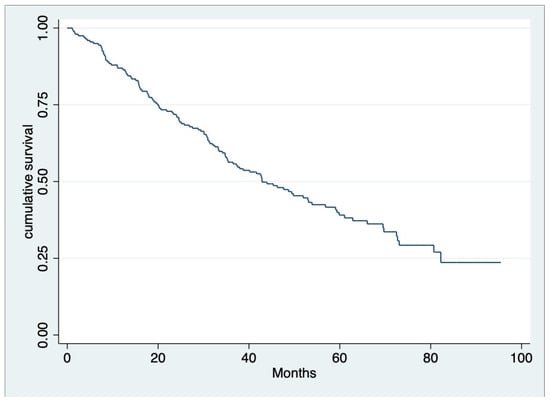
Figure 1
Open AccessArticle
Predictive Model for Occurrence of Febrile Neutropenia after Chemotherapy in Patients with Diffuse Large B-Cell Lymphoma: A Multicenter, Retrospective, Observational Study
by
Masaya Morimoto, Yuma Yokoya, Kikuaki Yoshida, Hideki Kosako, Yoshikazu Hori, Toshiki Mushino, Shinobu Tamura, Reiko Ito, Ryosuke Koyamada, Takuya Yamashita, Shinichiro Mori, Nobuyoshi Mori and Sachiko Ohde
Hematol. Rep. 2024, 16(1), 76-88; https://doi.org/10.3390/hematolrep16010008 - 07 Feb 2024
Abstract
►▼
Show Figures
Febrile neutropenia (FN) is a major concern in patients undergoing chemotherapy for diffuse large B-cell lymphoma (DLBCL); however, the overall risk of FN is difficult to assess. This study aimed to develop a model for predicting the occurrence of FN in patients with
[...] Read more.
Febrile neutropenia (FN) is a major concern in patients undergoing chemotherapy for diffuse large B-cell lymphoma (DLBCL); however, the overall risk of FN is difficult to assess. This study aimed to develop a model for predicting the occurrence of FN in patients with DLBCL. In this multicenter, retrospective, observational analysis, a multivariate logistic regression model was used to analyze the association between FN incidence and pretreatment clinical factors. We included adult inpatients and outpatients (aged ≥ 18 years) diagnosed with DLBCL who were treated with chemotherapy. The study examined 246 patients. Considering FN occurring during the first cycle of chemotherapy as the primary outcome, a predictive model with a total score of 5 points was constructed as follows: 1 point each for a positive hepatitis panel, extranodal involvement, and a high level of soluble interleukin-2 receptor and 2 points for lymphopenia. The area under the receiver operating characteristic curve of this model was 0.844 (95% confidence interval: 0.777–0.911). Our predictive model can assess the risk of FN before patients with DLBCL start chemotherapy, leading to better outcomes.
Full article

Figure 1
Open AccessArticle
The Gut Microbiome Correlated to Chemotherapy Efficacy in Diffuse Large B-Cell Lymphoma Patients
by
Zhuo-Fan Xu, Li Yuan, Yan Zhang, Wei Zhang, Chong Wei, Wei Wang, Danqing Zhao, Daobin Zhou and Jingnan Li
Hematol. Rep. 2024, 16(1), 63-75; https://doi.org/10.3390/hematolrep16010007 - 22 Jan 2024
Cited by 1
Abstract
►▼
Show Figures
The gut microbiome (GMB) has been extensively reported to be associated with the development and prognosis of human diseases. This study aims to investigate the relationship between GMB composition and chemotherapy efficacy in diffuse large B-cell lymphoma (DLBCL). We demonstrated that DLBCL patients
[...] Read more.
The gut microbiome (GMB) has been extensively reported to be associated with the development and prognosis of human diseases. This study aims to investigate the relationship between GMB composition and chemotherapy efficacy in diffuse large B-cell lymphoma (DLBCL). We demonstrated that DLBCL patients at diagnosis have altered GMB compositions. Significant enrichment of the Proteobacteria phylum in DLBCL patients was observed. Gene analysis showed a high abundance of virulence factors genes. We found baseline GMB to be associated with clinical outcomes. The emergence of Lactobacillus fermentum was correlated with better treatment outcome. Our pilot results suggested a correlation between GMB composition and DLBCL development and prognosis. Clues from our study, together with previous research, provided a rational foundation for further investigation on the pathogenesis, prognosis value, and targeted therapy of GMB in DLBCL.
Full article

Figure 1
Open AccessArticle
Survival Outcomes of Patients with Mantle Cell Lymphoma: A Retrospective, 15-Year, Real-Life Study
by
Emanuele Cencini, Natale Calomino, Marta Franceschini, Andreea Dragomir, Sara Fredducci, Beatrice Esposito Vangone, Giulia Lucco Navei, Alberto Fabbri and Monica Bocchia
Hematol. Rep. 2024, 16(1), 50-62; https://doi.org/10.3390/hematolrep16010006 - 18 Jan 2024
Abstract
►▼
Show Figures
Mantle cell lymphoma (MCL) prognosis has significantly improved in recent years; however, the possible survival benefit of new treatment options should be evaluated outside of clinical trials. We investigated 73 consecutive MCL patients managed from 2006 to 2020. For younger patients <65 years
[...] Read more.
Mantle cell lymphoma (MCL) prognosis has significantly improved in recent years; however, the possible survival benefit of new treatment options should be evaluated outside of clinical trials. We investigated 73 consecutive MCL patients managed from 2006 to 2020. For younger patients <65 years old, the median PFS was 72 months and we reported a 2-year, 5-year, and 10-year PFS of 73%, 62%, and 41%; median OS was not reached and we reported a 2-year, 5-year, and 10-year OS of 88%, 82%, and 66%. For patients aged 75 years or older, the median PFS was 36 months and we reported a 2-year, 5-year, and 10-year PFS of 52%, 37%, and 37%; median OS was not reached and we reported a 2-year, 5-year, and 10-year OS of 72%, 55%, and 55%. The median PFS was significantly reduced for patients treated between 2006 and 2010 compared to patients treated between 2011 and 2015 (p = 0.04). Interestingly, there was a trend towards improved OS for patients treated between 2016 and 2020 compared to between 2006 and 2010 and between 2011 and 2015 (5-year OS was 91%, 44%, and 33%). These findings could be due to the introduction of BR as a first-line regimen for elderly patients and to the introduction of ibrutinib as a second-line regimen.
Full article
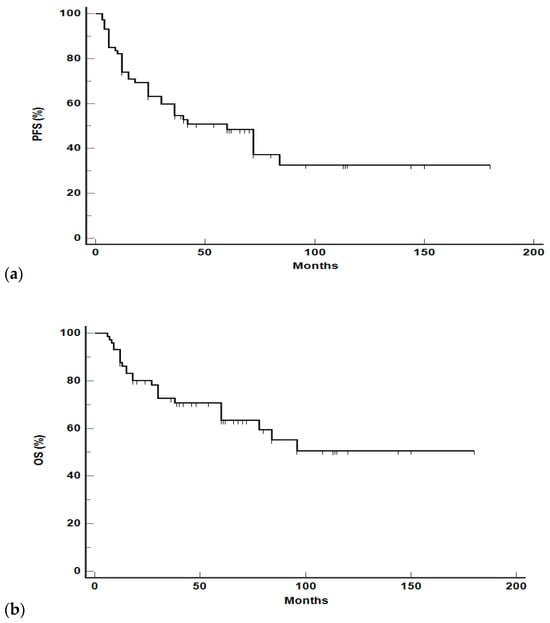
Figure 1
Highly Accessed Articles
Latest Books
E-Mail Alert
News
Topics
Topic in
BioMedInformatics, Cancers, Current Oncology, Hemato, Hematology Reports
Myeloma and Leukemia-Challenges and Current Treatment Options
Topic Editors: Giovanni Martinelli, Claudio CerchioneDeadline: 20 June 2024

Conferences
Special Issues
Special Issue in
Hematology Reports
Cell Therapies in Hematology: Current Updates and Perspectives
Guest Editor: Swati GargDeadline: 15 May 2024
Special Issue in
Hematology Reports
Personalized Therapies and Clinical Outcomes for Older Patients with Lymphoma
Guest Editor: Yamasaki SatoshiDeadline: 31 May 2024
Special Issue in
Hematology Reports
Comparison between 18F-FDG and Alternative Tracers for the Assessment of Hematological Ma-Lignancies
Guest Editors: Francesco Dondi, Domenico AlbanoDeadline: 27 June 2024
Special Issue in
Hematology Reports
State of the Art Papers from the XXXI IACRLD Symposium
Guest Editors: Ali Bazarbachi, Claudio Cerchione, Giovanni Martinelli, Giuseppe SaglioDeadline: 1 December 2024




